Chlorogenic Acid Alleviates Thiram-Induced Tibial Dyschondroplasia by Modulating Caspases, BECN1 Expression and ECM Degradation
Abstract
1. Introduction
2. Results
2.1. Clinical Observation during the Animal Experiment
2.2. Chlorogenic Acid Improves Performance of Chickens
2.3. Chlorogenic Acid Improves Tibial Index of Chickens
2.4. Chlorogenic Acid Improves Antioxidant Level of Chickens
2.5. Observation of H&E Staining
2.6. CGA Regulates Expression of Apoptotic and Autophagic Genes in Growth Plate
2.7. CGA Regulates Expression of ECM Catabolic Genes in Growth Plate
2.8. CGA Regulates Protein Expression of BECN1, CASP9 and MMP13 in Growth Plate
3. Discussion
4. Materials and Methods
4.1. Chickens Husbandry and Animal Ethics
4.2. Animal Experiment and Production Indicator Analysis
4.3. Sample Collection and Evaluation of Tibial Parameters
4.4. Biochemical Analysis
4.5. Hematoxylin and Eosin (H&E) Staining
4.6. RNA Extraction
4.7. qRT-PCR
4.8. Western Blotting Analysis
4.9. Statistical Analysis
Author Contributions
Funding
Acknowledgments
Conflicts of Interest
Abbreviations
| CGA | Chlorogenic acid |
| TD | Tibial dyschondroplasia |
| ECM | Extracellular Matrix |
References
- Fanxin, L.; Ornitz, D.M. Development of the endochondral skeleton. Cold Spring Harb. Perspect. Biol. 2013, 5, a008334. [Google Scholar]
- Gerber, H.P.; Ferrara, N. Angiogenesis and bone growth. Trends Cardiovasc. Med. 2000, 10, 223–228. [Google Scholar] [CrossRef]
- Pines, M.; Hurwitz, S. The role of the growth plate in longitudinal bone growth. Poult. Sci. 1991, 70, 1806–1814. [Google Scholar] [CrossRef] [PubMed]
- Vu, T.H. Don’t mess with the matrix. Nat. Genet. 2001, 28, 202–203. [Google Scholar] [CrossRef] [PubMed]
- Gibson, G.J.; Kohler, W.J.; Schaffler, M.B. Chondrocyte apoptosis in endochondral ossification of chick sterna. Dev. Dyn. 2010, 203, 468–476. [Google Scholar] [CrossRef]
- Leach, J.R. Current knowledge on the etiology of tibial dyschondroplasia in the avia species. Poult. Sci. 1992, 4, 57–65. [Google Scholar]
- Orth, M.W.; Peters, T.L.; Chlebek-Brown, K.A. Cartilage turnover in embryonic chick tibial explant cultures. Poult Sci. 2000, 79, 990–993. [Google Scholar] [CrossRef]
- Galluzzi, L.; Kumar, S.; Kroemer, G. Caspases Connect Cell-Death Signaling to Organismal Homeostasis. Immunity 2016, 44, 221–231. [Google Scholar] [CrossRef]
- Cinque, L.; Forrester, A.; Bartolomeo, R.; Svelto, M.; Venditti, R.; Montefusco, S.; Polishchuk, E.; Nusco, E.; Rossi, A.; Medina, D.L.; et al. FGF signalling regulates bone growth through autophagy. Nature 2015, 528, 272–275. [Google Scholar] [CrossRef]
- Jolene, B.; Shapiro, I.M.; Serge, L.; Hitoshi, W.; Vickram, S. PIM-2 is an independent regulator of chondrocyte survival and autophagy in the epiphyseal growth plate. J. Cell Physiol. 2010, 213, 246–251. [Google Scholar]
- Sumit, S.; Merlot, A.M.; Sukriti, K.; Jansson, P.J.; Richardson, D.R. Gene of the month: BECN1. J. Clin. Pathol. 2014, 67, 656–660. [Google Scholar]
- Hatori, M.; Klatte, K.J.; Teixeira, C.C.; Shapiro, I.M. End labeling studies of fragmented DNA in the avian growth plate: Evidence of apoptosis in terminally differentiated chondrocytes. J. Bone Miner. Res. Off. J. Am. Soc. Bone Miner. Res. 2010, 10, 1960–1968. [Google Scholar] [CrossRef] [PubMed]
- Gibson, G. Active role of chondrocyte apoptosis in endochondral ossification. Microsc. Res Tech. 2015, 43, 191–204. [Google Scholar] [CrossRef]
- Hwang, H.S.; Kim, H.A. Chondrocyte Apoptosis in the Pathogenesis of Osteoarthritis. Int. J. Mol. Sci. 2015, 16, 26035–26054. [Google Scholar] [CrossRef] [PubMed]
- Clifford, M.N.; Jaganath, I.B.; Ludwig, I.A.; Crozier, A. Chlorogenic acids and the acyl-quinic acids: Discovery, biosynthesis, bioavailability and bioactivity. Nat. Prod. Rep. 2017, 34, 1391. [Google Scholar] [CrossRef] [PubMed]
- Anne, H.B. Autophagy regulation and integration with cell signaling. Antioxid. Redox Signal. 2012, 17, 756–765. [Google Scholar]
- Lei-Lei, F.; Yan, C.; Bo, L. Beclin-1: Autophagic regulator and therapeutic target in cancer. Int. J. Biochem. Cell Biol. 2013, 45, 921–924. [Google Scholar]
- Tošović, J.; Marković, S.; Marković, J.M.D.; Mojović, M.; Milenković, D. Antioxidative mechanisms in chlorogenic acid. Food Chem. 2017, 237, 390. [Google Scholar] [CrossRef]
- Fazel, N.S.; Tejada, S.N.; Setzer, W.; Gortzi, O.; Sureda, A.; Braidy, N.; Daglia, M.; Manayi, A.; Mohammad, N.S. Chlorogenic acid and mental diseases: From chemistry to medicine. Curr. Neuropharmacol. 2017, 15, 471–479. [Google Scholar]
- Robert, D.; Olga, C.; Vesna, U.N.; NataA, K. Renoprotective mechanisms of chlorogenic acid in cisplatin-induced kidney injury. Toxicology 2014, 324, 98–107. [Google Scholar]
- Zhou, R.P.; Lin, S.J.; Wan, W.B.; Zuo, H.L.; Yao, F.F.; Ruan, H.B.; Xu, J.; Song, W.; Zhou, Y.C.; Wen, S.Y.; et al. Chlorogenic Acid Prevents Osteoporosis by Shp2/PI3K/Akt Pathway in Ovariectomized Rats. PloS ONE 2016, 11, e0166751. [Google Scholar] [CrossRef] [PubMed]
- Pan, T.; Cheng, T.F.; Jia, Y.R.; Li, P.; Li, F. Anti-rheumatoid arthritis effects of traditional Chinese herb couple in adjuvant-induced arthritis in rats. J. Ethnopharmacol. 2017, 205, 1–7. [Google Scholar] [CrossRef] [PubMed]
- Nabi, F.; Iqbal, M.K.; Zhang, H.; Rehman, M.U.; Shahzad, M.; Huang, S.; Han, Z.; Mehmood, K.; Ahmed, N.; Chachar, B.; et al. Clinical efficiency and safety of Hsp90 inhibitor Novobiocin in avian tibial dyschondroplasia. J. Vet. Pharmacol. Ther. 2018, 41, 902–911. [Google Scholar] [CrossRef] [PubMed]
- Caplan, A. The cellular and molecular embryology of bone formation. Bone Miner. Res. 1987, 5, 117–183. [Google Scholar]
- Ohyama, K.; Farquharson, C.; Whitehead, C.C.; Shapiro, I.M. Further observations on programmed cell death in the epiphyseal growth plate: Comparison of normal and dyschondroplastic epiphyses. J. Bone Miner. 2010, 12, 1647–1656. [Google Scholar] [CrossRef] [PubMed]
- Thompson, C.B. Apoptosis in the pathogenesis and treatment of disease. Science 1995, 267, 1456–1462. [Google Scholar] [CrossRef]
- Charlier, E.; Relic, B.; Deroyer, C.; Malaise, O.; Neuville, S.; Collée, J.; Malaise, M.; Seny, D. Insights on Molecular Mechanisms of Chondrocytes Death in Osteoarthritis. Int. J. Mol. Sci. 2016, 17, 2146. [Google Scholar] [CrossRef] [PubMed]
- Svandova, E.; Vesela, B.; Tucker, A.S.; Matalova, E. Activation of Pro-apoptotic Caspases in Non-apoptotic Cells During Odontogenesis and Related Osteogenesis. Front. Physiol. 2018, 9, 174. [Google Scholar] [CrossRef]
- Rath, N.C.; Huff, W.E.; Bayyari, G.R.; Balog, J.M. Cell death in avian tibial dyschondroplasia. Avian Dis. 1998, 42, 72–79. [Google Scholar] [CrossRef]
- Marie, N.; Sabine, S.D.; Véronique, B.; Rasha, A.S.; Chantal, C.; Majlinda, T.; David, M.; Michel, S.; Sophie, P.; Laurance, C.; et al. Autophagy in osteoblasts is involved in mineralization and bone homeostasis. Autophagy 2014, 10, 1965–1977. [Google Scholar]
- Sui, X.; Li, Y.; Sun, Y.; Li, C.; Li, X.; Zhang, G. Expression and significance of autophagy genes LC3, Beclin1 and MMP-2 in endometriosis. Exp. Ther. Med. 2018, 16, 1958–1962. [Google Scholar] [CrossRef] [PubMed]
- Weng, J.; Wang, C.; Wang, Y.; Tang, H.; Liang, J.; Liu, X.; Huang, H.; Hou, J. Beclin1 inhibits proliferation, migration and invasion in tongue squamous cell carcinoma cell lines. Oral. Oncol. 2014, 50, 983–990. [Google Scholar] [CrossRef] [PubMed]
- Vu, T.H.; Shipley, J.M.; Bergers, G.; Berger, J.E.; Helms, J.A.; Hanahan, D.; Shapiro, S.D.; Senior, R.M.; Werb, Z. MMP-9/Gelatinase B Is a Key Regulator of Growth Plate Angiogenesis and Apoptosis of Hypertrophic Chondrocytes. Cell 1998, 93, 411–422. [Google Scholar] [CrossRef]
- Dan, H.; Simsa-Maziel, S.; Hisdai, A.; Sela-Donenfeld, D.; Monsonego Ornan, E. Expression of matrix metalloproteinases during impairment and recovery of the avian growth plate. J. Anim. Sci. 2009, 87, 3544–3555. [Google Scholar] [CrossRef] [PubMed]
- Luisa, B.; Jinlong, L.; Gorna, M.W.; Qing, Z.; Russia, H.V.; Ana Belinda, C.X.; Sheila, U.; Jacques, S.B.; Antony, L.B.; Brian, S.; et al. MMP13 mutations are the cause of recessive metaphyseal dysplasia, Spahr type. Am. J. Med. Genet. Part A 2014, 164, 1175–1179. [Google Scholar]
- Rath, N.C.; Huff, W.E.; Balog, J.M.; Bayyari, G.R.; Reddy, R.P. Matrix metalloproteinase activities in avian tibial dyschondroplasia. Poult. Sci. 1997, 76, 501–505. [Google Scholar] [CrossRef] [PubMed]
- Kai, K.; Plaks, V.; Werb, Z. Matrix Metalloproteinases: Regulators of the Tumor Microenvironment. Cell 2010, 141, 52–67. [Google Scholar]
- Ekkehart, L.; Romy, K.; Katja, H.; Valerie, C.D.; Sarah, N.; Gen, N.; Sheila, U.; Jürgen, S. Mutations in MMP9 and MMP13 determine the mode of inheritance and the clinical spectrum of metaphyseal anadysplasia. Am. J. Hum. Genet. 2009, 85, 168–178. [Google Scholar]
- Levine, B.; Klionsky, D.J. Development by self-digestion; molecular mechanisms and biological functions of autophagy. Dev. Cell. 2004, 6, 463–477. [Google Scholar] [CrossRef]
- Wirawan, E.; Walle, L.V.; Kersse, K.; Cornelis, S.; Claerhout, S.; Vanoverberghe, I.; Roelandt, R.; De Rycke, R.; Verspurten, J.; Declercq, W.; et al. Caspase-mediated cleavage of Beclin-1 inactivates Beclin-1-induced autophagy and enhances apoptosis by promoting the release of proapoptotic factors from mitochondria. Cell Death Dis. 2010, 1, e18. [Google Scholar] [CrossRef]
- Tian, W.X.; Li, J.K.; Qin, P.; Wang, R.; Ning, G.B.; Qiao, J.G.; Li, H.Q.; Bi, B.R.; Pan, S.Y.; Guo, D.Z. Screening of differentially expressed genes in the growth plate of broiler chickens with Tibial Dyschondroplasia by microarray analysis. BMC Genom. 2013, 14, 276. [Google Scholar] [CrossRef] [PubMed]
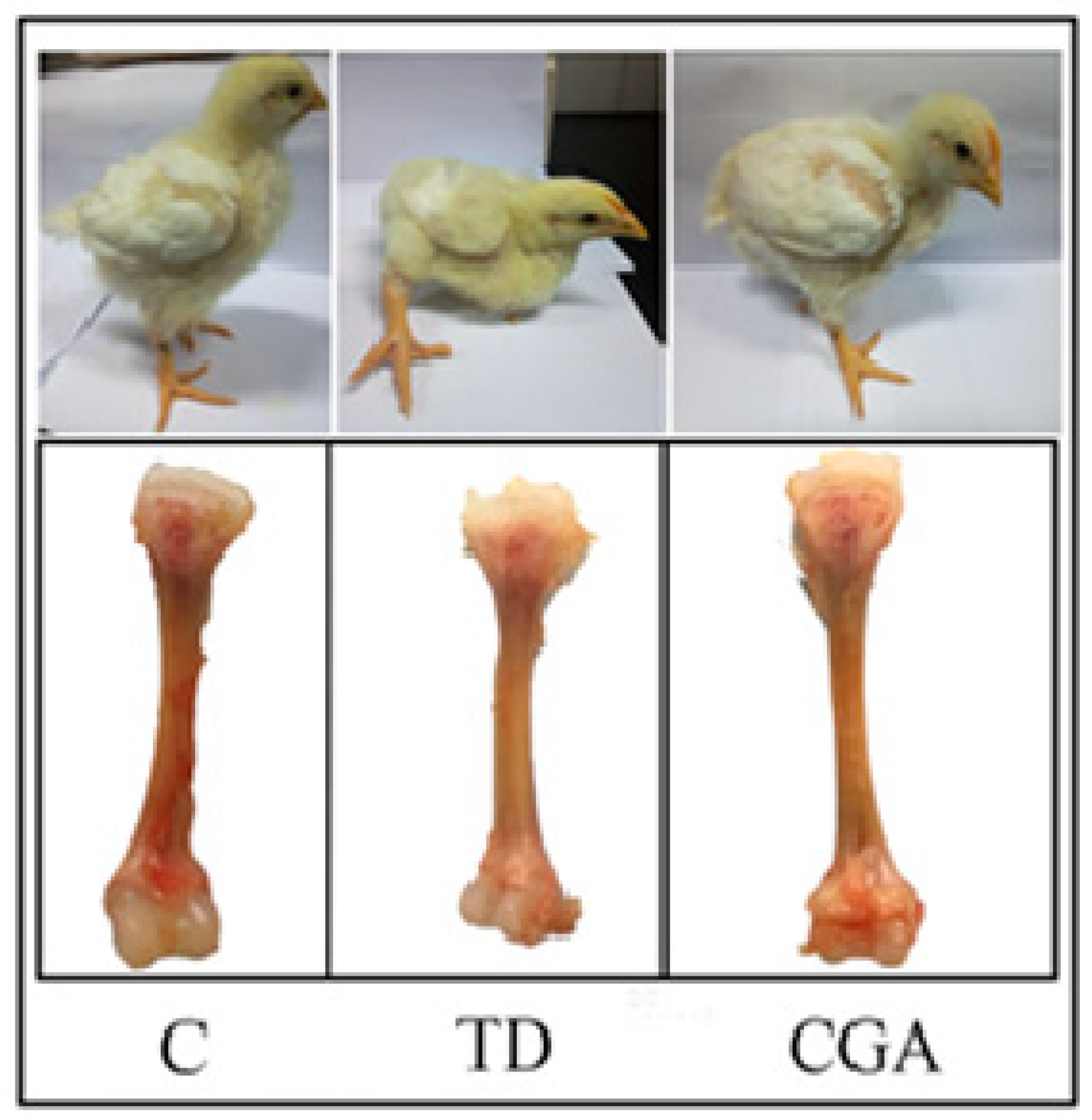
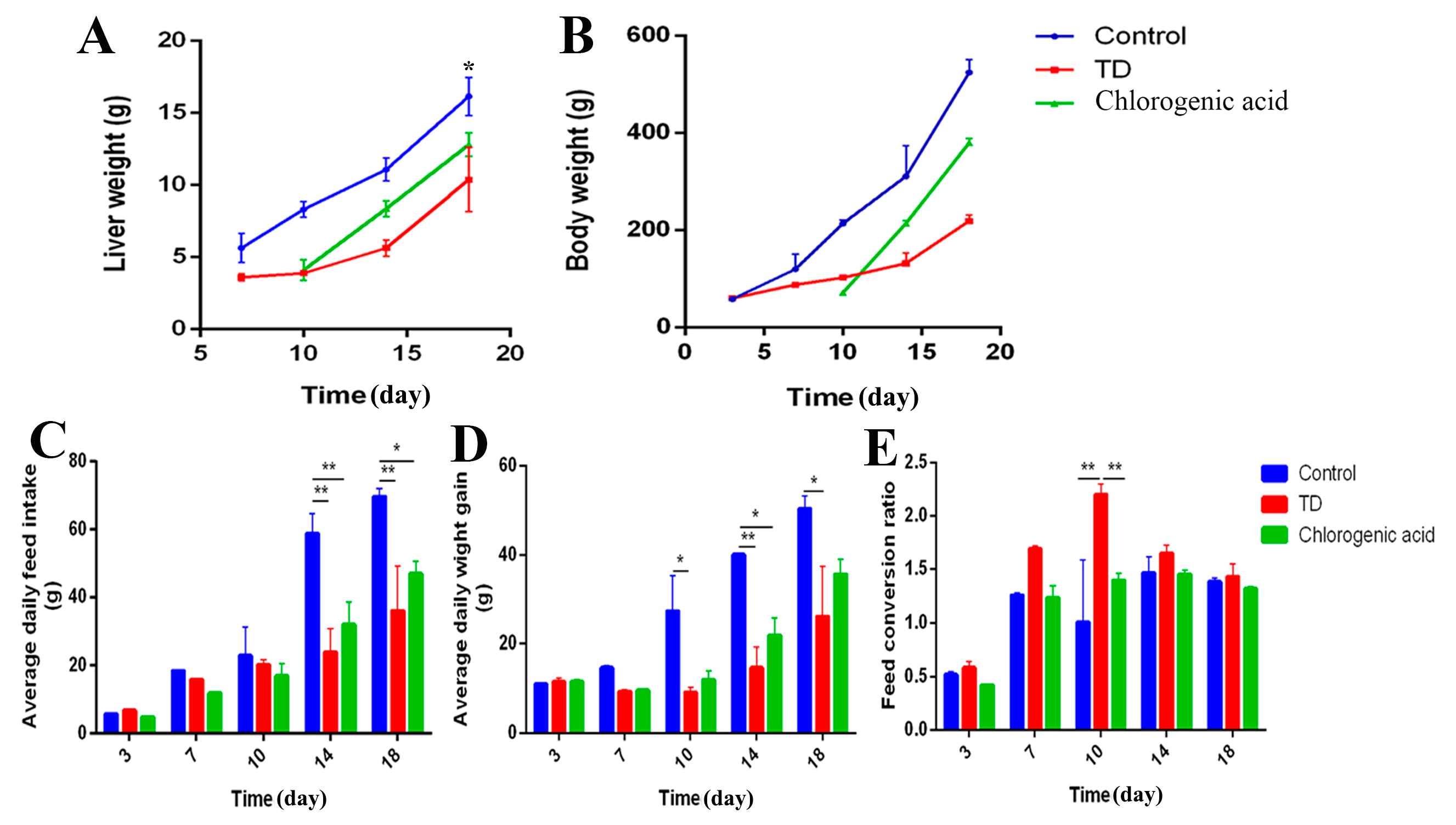
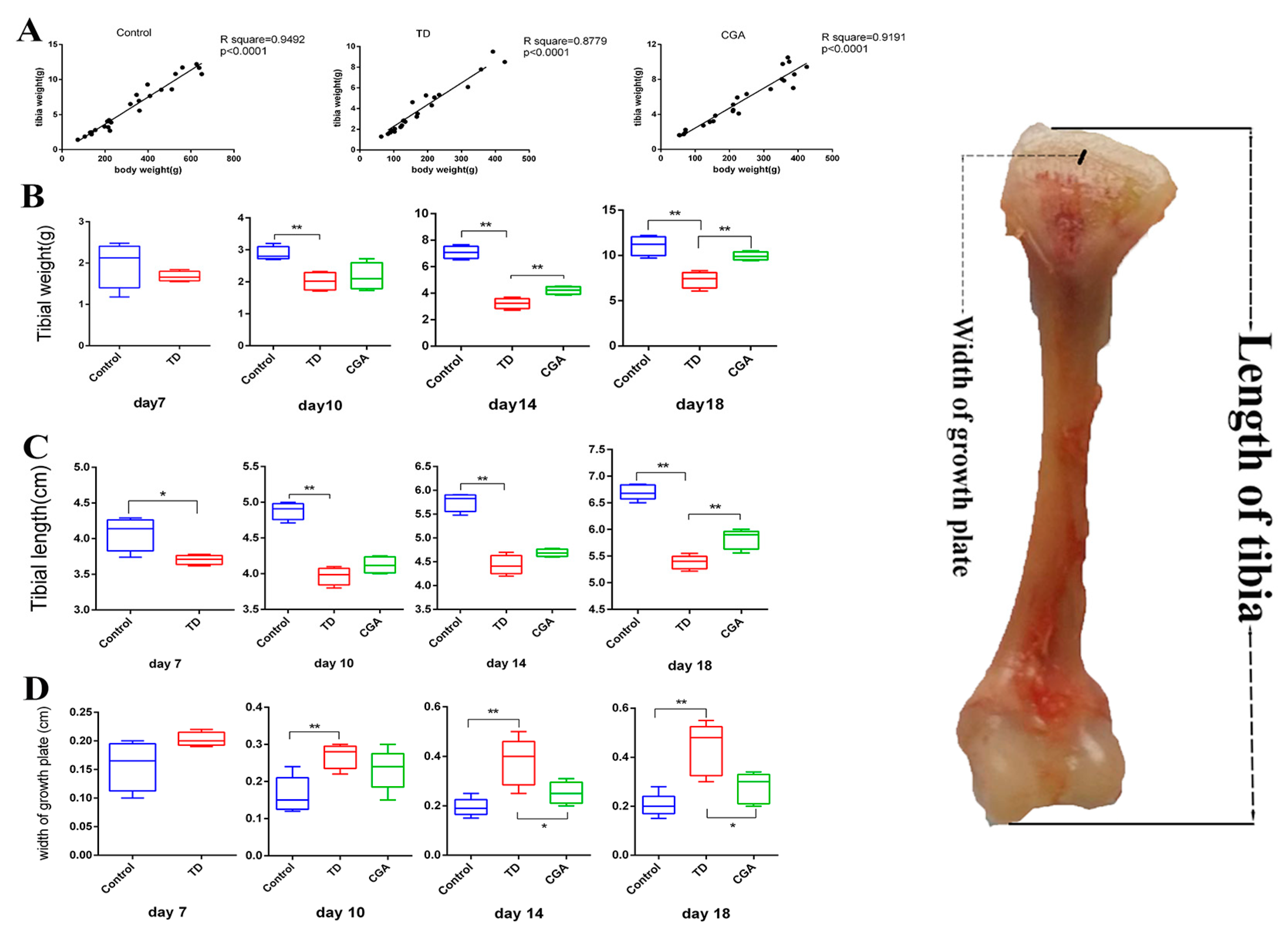


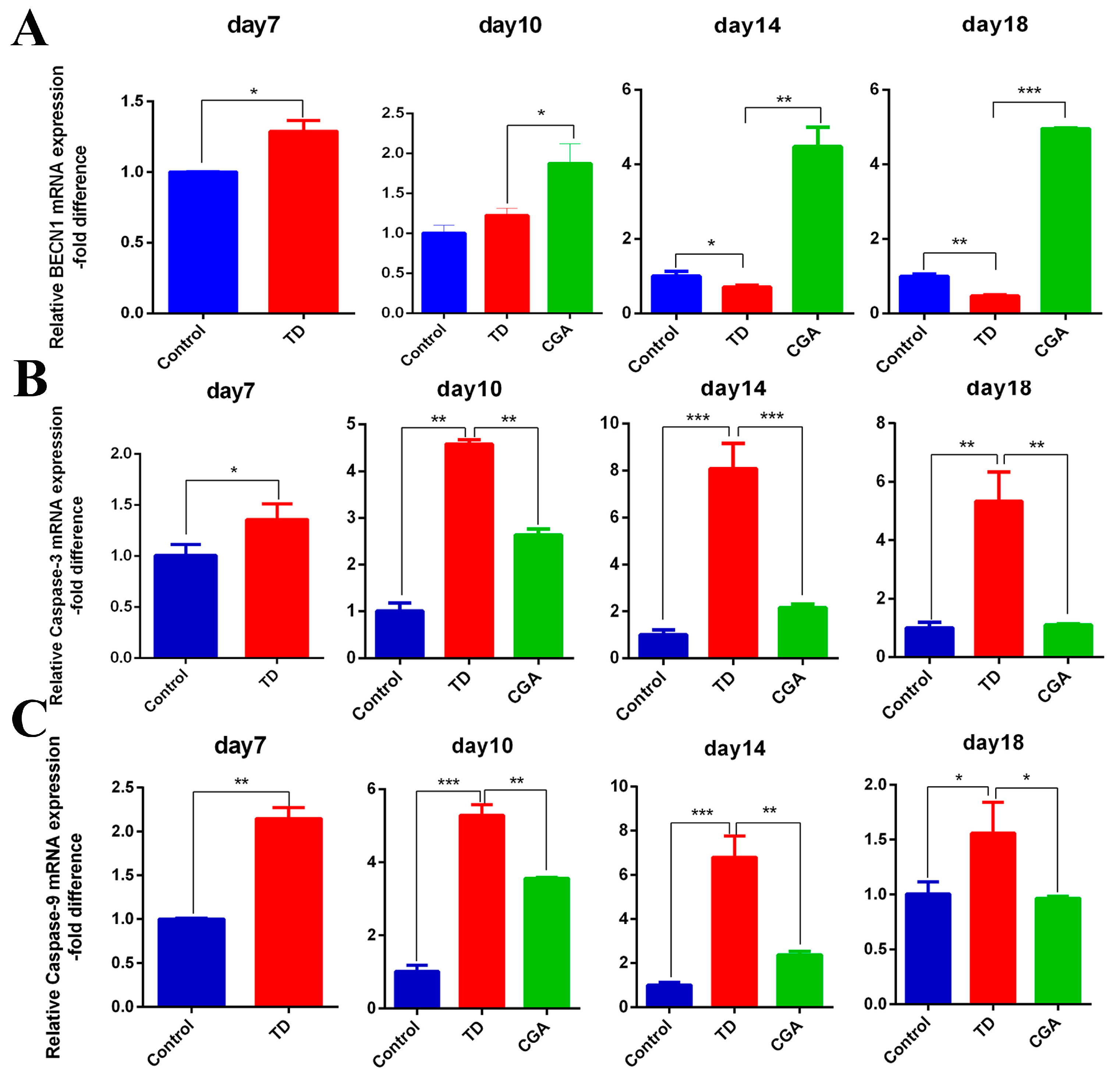
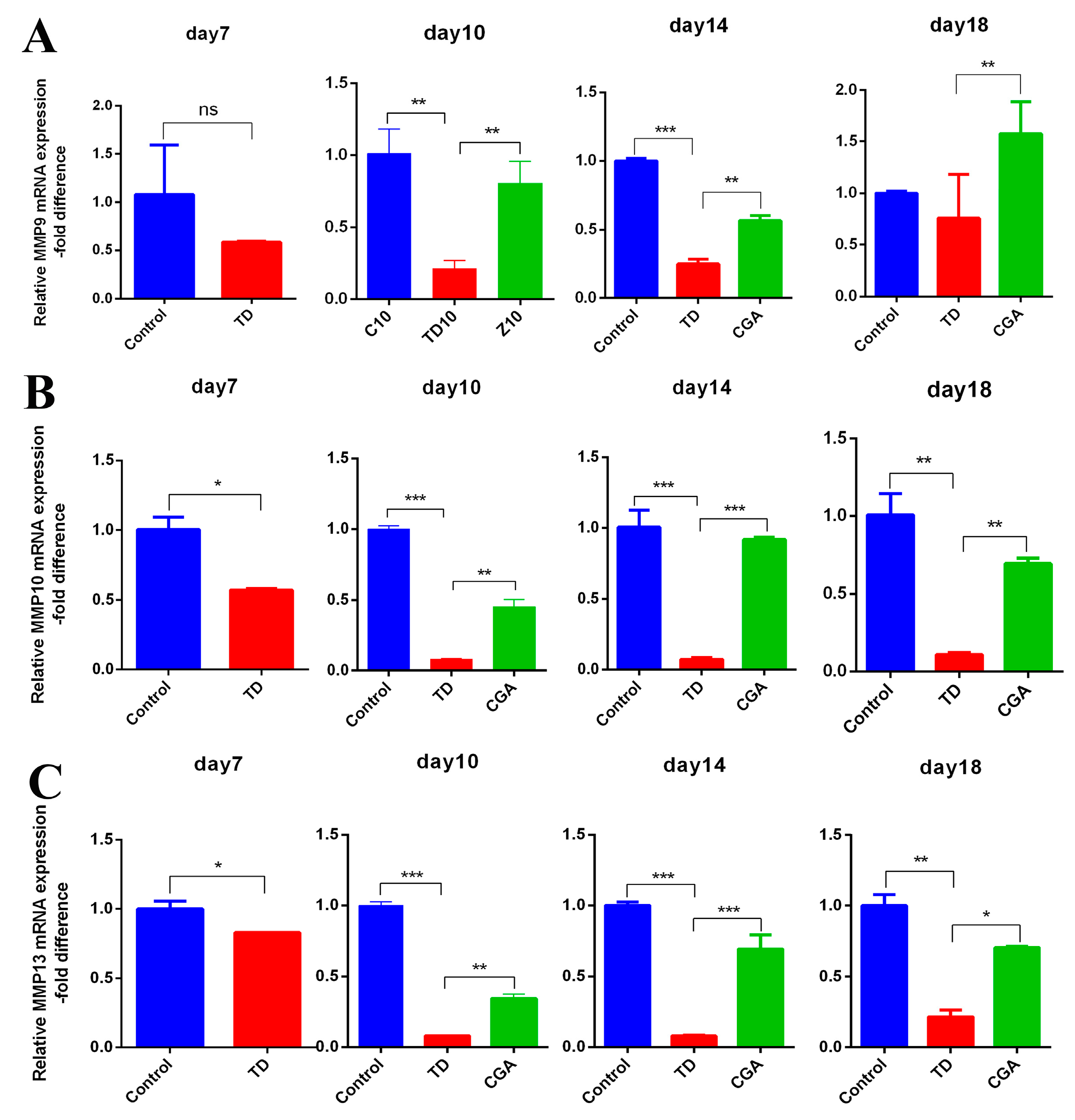

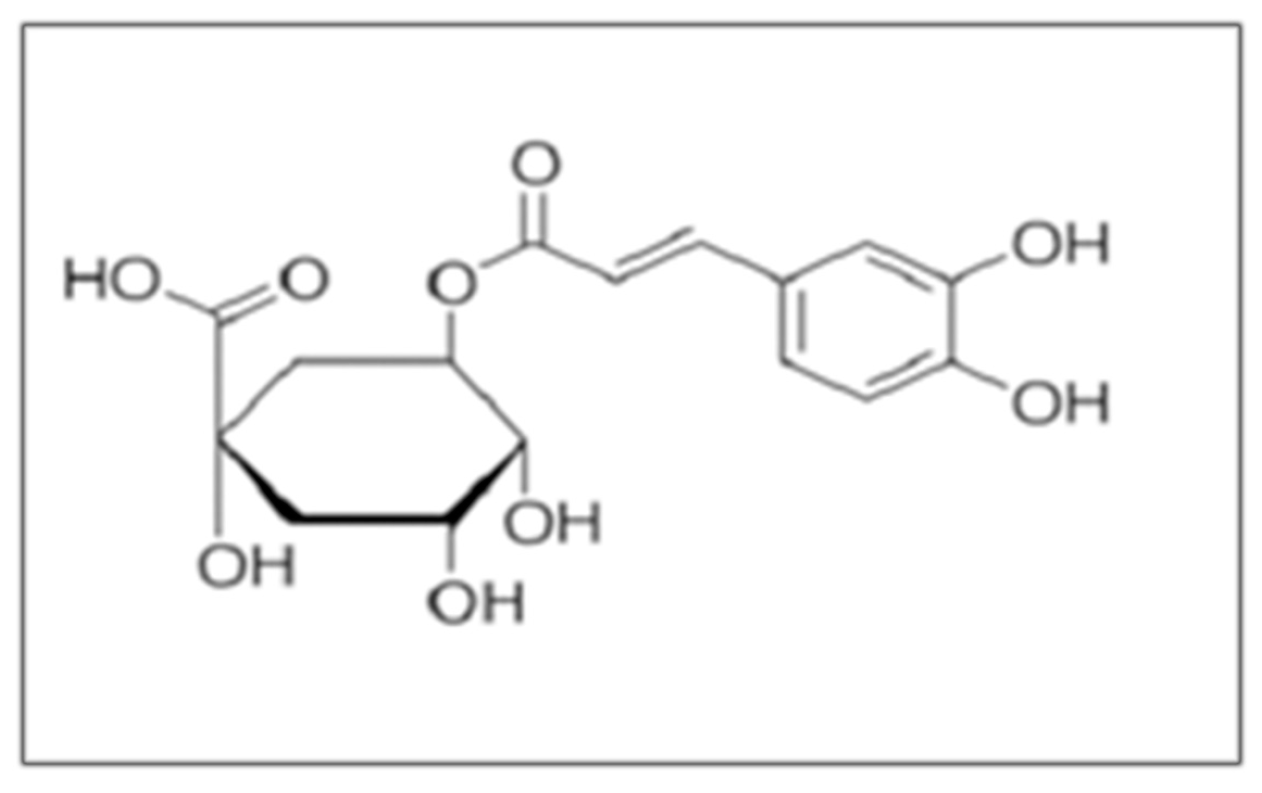
| Name | Primer Sequence (5′-3′) | Accession Number | Product Size |
|---|---|---|---|
| Beclin1 | CGACTGGAGCAGGAAGAAG | NM_001006332.1 | 115 bp |
| TCTGAGCATAACGCATCTGG | |||
| MMP-9 | ATGAACTACTCCCCCGACCTG | NM_204667.1 | 258 bp |
| AGTCCAGAACTCATCATCATCG | |||
| MMP-10 | TGCTTCTGGATTTCACGGTG | NM_001278089.1 | 101 bp |
| AGTGGGCATCCCCTCCTATC | |||
| MMP-13 | CAACCCAAAACATCCCAAAAC | NM_001293090.1 | 258 bp |
| CCATTCATAGCCCAAACCTTC | |||
| Caspase-3 | ACTCTGGAATTCTGCCTGATGACA | NM_204725.1 | 129 bp |
| CATCTGCATCCGTGCCTGA | |||
| Caspase-9 | ATTCCTTTCCAGGCTCCATC | XM_424580.6 | 130 bp |
| CACTCACCTTGTCCCTCCAG | |||
| GAPDH | CCTTCATTGACCTTCACTACATGGTCTA | NM_204305.1 | 127 bp |
| TGGAAGATGGTGATGGCCTTTCCATTG |
© 2019 by the authors. Licensee MDPI, Basel, Switzerland. This article is an open access article distributed under the terms and conditions of the Creative Commons Attribution (CC BY) license (http://creativecommons.org/licenses/by/4.0/).
Share and Cite
Zhang, J.; Huang, S.; Tong, X.; Zhang, L.; Jiang, X.; Zhang, H.; Mehmood, K.; Li, J. Chlorogenic Acid Alleviates Thiram-Induced Tibial Dyschondroplasia by Modulating Caspases, BECN1 Expression and ECM Degradation. Int. J. Mol. Sci. 2019, 20, 3160. https://doi.org/10.3390/ijms20133160
Zhang J, Huang S, Tong X, Zhang L, Jiang X, Zhang H, Mehmood K, Li J. Chlorogenic Acid Alleviates Thiram-Induced Tibial Dyschondroplasia by Modulating Caspases, BECN1 Expression and ECM Degradation. International Journal of Molecular Sciences. 2019; 20(13):3160. https://doi.org/10.3390/ijms20133160
Chicago/Turabian StyleZhang, Jialu, Shucheng Huang, Xiaole Tong, Lihong Zhang, Xiong Jiang, Hui Zhang, Khalid Mehmood, and Jiakui Li. 2019. "Chlorogenic Acid Alleviates Thiram-Induced Tibial Dyschondroplasia by Modulating Caspases, BECN1 Expression and ECM Degradation" International Journal of Molecular Sciences 20, no. 13: 3160. https://doi.org/10.3390/ijms20133160
APA StyleZhang, J., Huang, S., Tong, X., Zhang, L., Jiang, X., Zhang, H., Mehmood, K., & Li, J. (2019). Chlorogenic Acid Alleviates Thiram-Induced Tibial Dyschondroplasia by Modulating Caspases, BECN1 Expression and ECM Degradation. International Journal of Molecular Sciences, 20(13), 3160. https://doi.org/10.3390/ijms20133160







